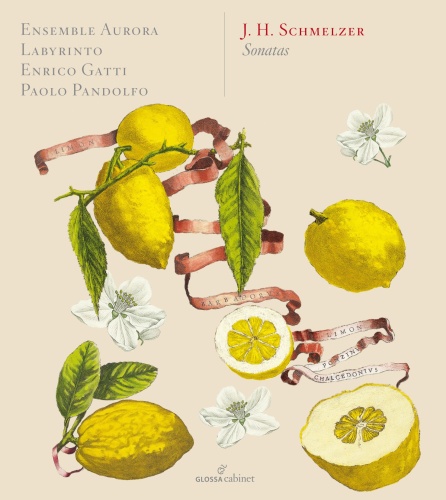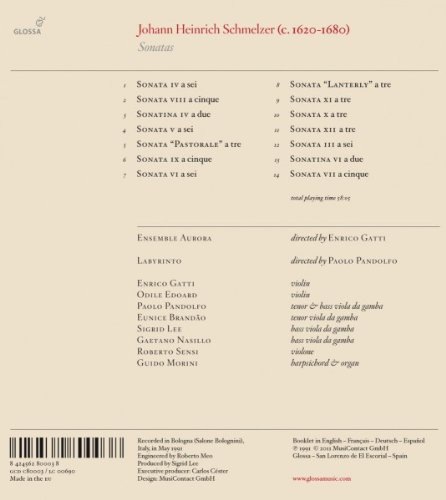
classical music distribution


(Produkt nie został jeszcze oceniony)
kompozytor
Schmelzer, Johann Heinrich
tytuł
Schmelzer: Sonatas
wykonawcy
Ensemble Aurora;
Gatti, Enrico;
Pandolfo, Paolo;
Ensemble Labyrinto
Gatti, Enrico;
Pandolfo, Paolo;
Ensemble Labyrinto
nr katalogowy
GCD C80003
opis
This 1991 recording unusually featured a pair of small Italian groups, Labyrinto and Ensemble Aurora, performing together and separately in ensemble sonatas of various sizes by Austrian composer and violinist Johann Heinrich Schmelzer. It's hard to pick out one group from the other, and indeed, the packaging does not indicate to which group each of the eight individual players belongs. The sonatas are all in the typical style of mid-17th-century Italy, with alternating short sections of contrasting tempo and rhythm that may bring to mind the contrast between light and dark in Baroque painting. The consistent, rather tinkly sound of the string group and the sameness of the musical form may make for a long haul for listeners without a particular interest in instrumental music of the period (these sonatas are drawn from sets published in 1659 and 1662); they would never have been performed back to back in sets like this. But the album, which was reissued by Glossa in 2011, can be recommended to fans of Baroque instrumental music. Schmelzer, a generation before Biber, was a less wildly original composer, but the same imaginative treatment of Italian models is audible in these works. Sample the "Pastorale sonata a tre" (track 5) with its unexpected treatments of its initial 6/8 material for one instance. The harpsichord and organ continuo of keyboardist Guido Morini was notable for its lively, active quality in 1991, and it still sounds good two decades later. The attractive still-life drawing on the cover of the Glossa version is another point in its favor, as is the fact that recordings of Schmelzer remain scarce.
nośnik
CD
gatunek
Muzyka klasyczna
producent
Glossa
data wydania
16-08-2011
EAN / kod kreskowy
8424562800038

(Produkt nie został jeszcze oceniony)
cena 45,00 zł
lubProdukt na zamówienie
Wysyłka ustalana indywidualnie.
Darmowa wysyłka dla zamówień powyżej 300 zł!
Darmowy kurier dla zamówień powyżej 500 zł!
sprawdź koszty wysyłkiProduktu jeszcze nie zrecenzowano, chcesz być pierwszy?
Klienci, którzy kupili ten produkt, kupili również
różni kompozytorzy
A musical tribute to Johannes Ockeghem († 1497) - Pierre la Rue, Obrecht, Desprez, Busnoys, ...
AECD 1226
Berlioz, Hector
Berlioz: Harold en Italie; Rêverie and Caprice; Le carnaval romain; Benvenuto Cellini
8.573297
Schumann, Robert, Bruckner, Anton
Vienna Philharmonic - Martha Argerich & Zubin Mehta (BD)
764604
różni kompozytorzy, Gade, Niels Wilhelm, Langgaard, Rued
Danish Romantic Piano Trios - Gade; Lange-Müller; Langgaard
8.226119
Pozostałe płyty tego kompozytora
różni kompozytorzy
Adoration - Monteverdi; Bach; Sances; Zelenka; Szarzyński; Schmelzer; Cavalli; ...
99112
Biber, Heinrich Ignaz Franz, Schmelzer, Johann Heinrich, różni kompozytorzy
Violinwerke des Dresdner Schule
RIC 232
różni kompozytorzy
Trombett-undt musikalischer Taffeldienst - Biber, Rittler, Schmelzer, Vejvanovsky, …
FB 1209232
Schmelzer, Johann Heinrich
Schmelzer: La Margarita - Musica per la corte di Vienna e Praga
A 339
Schmelzer, Johann Heinrich
Schmelzer: The Emperor's Fiddler - Sonatae unarum fidium
OBSCD 718
Pozostałe płyty tego wykonawcy
różni kompozytorzy
L’Arte del Violino in Italia (1650-1700) - Matteis, Merula, Pandolfi, Uccellini, Viviani, Bononcini, Torelli, ...
GCD 921206
Abel, Carl Friedrich
Abel: The Drexel Manuscript - 2 Suites in D major, Suite in D minor, Two pieces in A major
GCD 920410
różni kompozytorzy, Abel, Carl Friedrich, Corkine, William
A SOLO - music for viola da gamba; Ortiz; Corkine; Abel; ...
GCD P30403
Napisz recenzję dla: Schmelzer: Sonatas
Zapytaj o dostępność produktu
Twoje zapytanie:
Odpowiemy na adres:
Produkt został dodany do koszyka

Schmelzer, Johann Heinrich
Schmelzer: Sonatas
1 szt











































